
The United Kingdom is the best location for wind power in Europe and one of the best in the world. The combination of long coastline, shallow water and strong winds make offshore wind unusually effective.

Wind power in Germany is a growing industry. The installed capacity was 55.6 gigawatts (GW) at the end of 2017, with 5.2 GW from offshore installations. In 2020, 23.3% of the country's total electricity was generated through wind power, up from 6.2% in 2010 and 1.6% in 2000.
The Ripley Wind Power Project is a 76 megawatt (MW) wind power project near Ripley, Ontario.

Wind power is the fastest-growing renewable energy technology in Scotland, with 11,482 megawatts (MW) of installed wind power capacity by Q1 2023. This included 9,316 MW from onshore wind in Scotland and 2,166 MW of offshore wind generators.
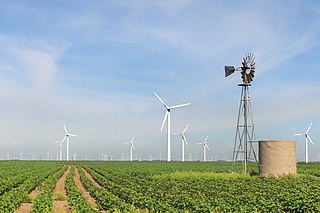
The Roscoe Wind Farm near Roscoe, Texas is one of the world's largest-capacity wind farms. With 627 wind turbines and a total installed capacity of 781.5 MW, owned and operated by RWE. At the time of its completion in 2009, it was the largest wind farm in the world, surpassing the nearby 735.5-megawatt Horse Hollow Wind Energy Center. In 2012, it was overtaken by California's 1,020-megawatt Alta Wind Energy Center.

Offshore Windpark Egmond aan Zee (OWEZ) is an offshore wind farm in the Dutch part of the North Sea, located approximately 10 km from the coast near Egmond aan Zee. It was the first large-scale offshore wind farm to be built off the Dutch North Sea coast. The wind farm was built by NoordzeeWind, a joint venture consisting of Shell and Nuon.
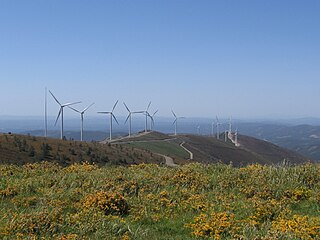
Wind power is a major source of electricity in Portugal. At the end of 2020, wind power capacity in Continental Portugal was 5,456 MW. In 2020, wind power represented 23.7% of total electricity generation.
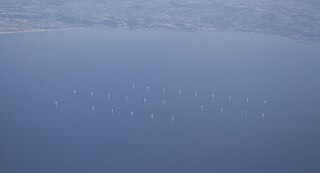
Rhyl Flats Offshore Wind Farm is a 25 turbine wind farm approximately 8 km north east of Llandudno in North Wales. It is Wales' second offshore wind farm and the third offshore wind farm to be built within Liverpool Bay. It has a maximum rated output of 90 MW.
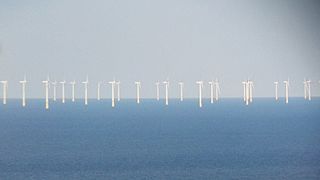
Gwynt y Môr is a 576-megawatt (MW) offshore wind farm located off the coast of Wales and is the fifth largest operating offshore windfarm in the world. The farm has 160 wind turbines of 150 metres (490 ft) tip height above mean sea level.

Whitelee Wind Farm is a windfarm on the Eaglesham moor in Scotland. The main visitor centre is located in East Renfrewshire, but the majority of turbines are located in East Ayrshire and South Lanarkshire. It is the largest on-shore wind farm in the United Kingdom with 215 Siemens and Alstom wind turbines and a total capacity of 539 megawatts (MW), with the average of 2.5 MW per turbine. Whitelee was developed and is operated by ScottishPower Renewables, which is part of the Spanish company Iberdrola.
The Markbygden Wind Farm is a series of interconnected wind farms in the Markbygden area west of Piteå, Norrbotten County in northern Sweden. The project is expected to be completed by 2025 and could have a total capacity of up to 4,000 megawatts (MW), comprising up to 1,101 wind turbines. The project was initially co-developed by Svevind AB and wind turbine manufacturer Enercon. Combined the Markbygden Wind Farm is already the biggest wind farm in Europe, on track to be one of the biggest onshore windfarms in the world.

In terms of wind power development, Morocco enjoys quite favourable wind resource patterns, both in the northern part of the country near Tanger and to the west where certain regions benefit from regular trade winds.

DanTysk is a 288 megawatt (MW) offshore wind farm in the North Sea 70 kilometres (43 mi) west of the island Sylt, in the German EEZ at the border to Denmark. The wind farm operates 80 Siemens Wind Power's SWT-3.6-120 turbines with a capacity of 3.6 MW each.
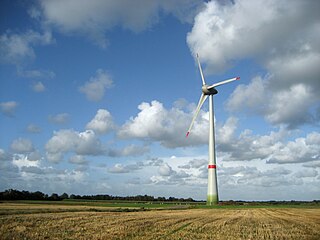
The Enercon E-126 is an onshore wind turbine model manufactured by the German company Enercon. With a hub height of 135 m (443 ft), rotor diameter of 126 m (413 ft) and a total height of 198 m (650 ft), the turbine can generate up to 7.58 megawatts of power, making it the largest wind turbine in the world for several years, until it was overtaken in 2014 by the Danish company Vestas with their V164-8.0 turbine. Their model number is a reference to their rotor diameter.

Wind power in Belgium depends partially on regional governments and partially on the Belgian federal government. Wind energy producers in both the Flemish and Walloon regions get green certificates but not with the same conditions.

As of November 2023, wind power in the Netherlands has an installed capacity of 11,602 MW, 40.9% of which is based offshore. In 2022, the wind turbines provided the country with 18.37% of its electricity demand during the year. Windmills have historically played a major part in the Netherlands by providing an alternative to water driven mills.
Triton Knoll Wind Farm is an 857 MW round 2 offshore wind farm nearing completion 33 kilometres (21 mi) off the coast of Lincolnshire, in the North Sea, England.

The great majority of wind turbines around the world belong to individuals or corporations who use them to generate electric power or to perform mechanical work. As such, wind turbines are primarily designed to be working devices. However, the large size and height above surroundings of modern industrial wind turbines, combined with their moving rotors, often makes them among the most conspicuous objects in their areas. A few localities have exploited the attention-getting nature of wind turbines by placing them on public display, either with visitor centers on their bases, or with viewing areas farther away. The wind turbines themselves are generally of conventional horizontal-axis, three-bladed design, and generate power to feed electrical grids, but they also serve the unconventional roles of technology demonstration, public relations, and education.

Wind power in the Philippines accounts for a total of 443MW as of 2020 according to the Department of Energy, covering about 1.6% of the country's total installed capacity for both renewable and non-renewable energy sources. When it comes to existing renewable energy sources in the country, wind power has a total share of approximately 5.4%. Despite currently being a small contributor to the country's energy mix, wind power installations have increased from 33MW in 2012-2013 to 337MW in 2014, 427MW in 2015-2018, and 443MW in 2019-2021. Moreover, the Department of Energy's National Renewable Energy Plan (NREP) 2020-2040 aims to commission 2,345MW of total wind power capacity by 2030. There has been a setback, however, as the wind power industry was moderately affected by COVID, particularly in the import of wind turbines. Due to this, several projects such as the Aklan onshore wind project got delayed. To further drive the wind energy sector in the country, an increased demand for renewable energy, greater government commitments, and reduced wind power tariff are needed.

Wind power is a major industry in Taiwan. Taiwan has abundant wind resources however a lack of space on land means that most major developments are offshore. As of February 2020, there were 361 installed onshore turbines and 22 offshore turbines in operation with the total installed capacity of 845.2 MW.


















